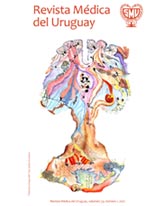Restrictive transfusion strategy in orthopedics surgery
Abstract
Major orthopedic surgery is the surgical solution proposed for patients who suffer from advanced arthrosis or for some cases of hip fracture. Some of these patients will require blood and/or blood components transfusion before or after surgery.
The approach to anemia in surgical patients may involve a liberal or a restrictive transfusion strategy, according to what each surgeon indicates, or observing the context of a restrictive protocol for blood replacement.
The latter results in resource savings and in a reduction in the number of complications due to the administration of allogenic blood.
The study aims to compare the liberal transfusion strategy to the restrictive strategy. 498 patients were included in the study, 261 of which (52.4%) were treated within the liberal strategy in 2014, and 237 (47.6%) were treated according to a restrictive transfusion protocol in 2015. A smaller number of individuals received blood transfusions and 55% less blood volumes were needed when the restrictive strategy was applied.
Ten cases of transfusion reaction arose, all of them involving fever, 8 in 2014 and 2 in 2015. As to the functional evolution, no differences were found between the two groups.
According to our study, and according to the global literature consulted, the restrictive therapy strategy enables the same functional results with a lower risk for patients, and it saves resources for the system.
References
(1) Fondo Nacional de Recursos. Artroplastia de cadera por artrosis. Montevideo: FNR, 2010.
(2) Fondo Nacional de Recursos. Artroplastia de cadera por frasctura. Montevideo: FNR, 2010.
(3) Fondo Nacional de Recursos. Artroplastia de rodilla. Montevideo: FNR, 2010.
(4) Organización Mundial de la Salud. Concentraciones de hemoglobina para diagnosticar la anemia y evaluar su gravedad. Ginebra: OMS, 2011. Disponible en: http://www.who.int/ vmnis/indicators/haemoglobin_es.pdf.
(5) Kassebaum NJ; GBD 2013 Anemia Collaborators.The Global Burden of Anemia. HematolOncolClin North Am 2016; 30(2):247-308.
(6) Madrazo González, Z, García Barrasa A, Rodríguez Lorenzo L, RafecasRenau A, Alonso Fernández G. Actualización en anemia y terapia transfusional. Med Intensiva 2011; 35(1):32-40.
(7) Carson JL, Terrin ML, Noveck H, Sanders DW, Chaitman BR, Rhoads GG, et al. Liberal or restrictive transfusion in high-risk patients after hip surgery. N Engl J Med 2011; 365(26):2453-62.
(8) Toy P, Popovsky MA, Abraham E, Ambruso DR, Holness LG, Kopko PM, et al; National Heart, Lung and Blood Institute Working Group on TRALI. Transfusion-related acute lung injury: definition and review. Crit Care Med 2005; 33(4):721-6.
(9) Organización Mundial de la Salud. El uso clínico de la sangre: manual de bolsillo. Ginebra: OMS, 2001.
(10) Mao T, Gao F, Han J, Sun W, Guo W, Li Z, et al. Restrictive versus liberal transfusion strategies for red blood cell transfusion after hip or knee surgery: a systematic review and meta-analysis. Medicine (Baltimore) 2017; 96(25):e7326.
(11) Carson JL, Sieber F, Cook DR, Hoover DR, Noveck H, Chaitman BR, et al. Liberal versus restrictive blood transfusion strategy: 3-year survival and cause of death results from the FOCUS randomised controlled trial. Lancet 2015; 385(9974):1183-9.
(12) Brunskill SJ, Millette SL, Shokoohi A, Pulford EC, Doree C, Murphy MF, et al. Red blood cell transfusion for people undergoing hip fracture surgery. Cochrane DatabaseSystRev 2015; (4):CD009699.
(13) García García E. Pautas transfusionales en el paciente quirúrgico. Rev Cuba AnestesiolReanim 2013; 12(3):231-43.
(14) Gregersen M, Borris LC, Damsgaard EM. Postoperative blood transfusion strategy in frail, anemic elderly patients with hip fracture: the TRIFE randomized controlled trial. ActaOrthop 2015; 86(3):363-72.
(15) Carson JL, Guyatt G, Heddle NM, Grossman BJ, Cohn CS, Fung MK, et al. Clinical practice guidelines from the AABB: red blood cell transfusion thresholds and storage. JAMA 2016; 316(19):2025-2035.

This work is licensed under a Creative Commons Attribution-NonCommercial 4.0 International License.













